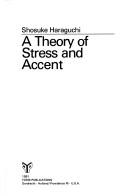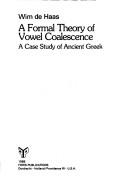| Listing 1 - 10 of 10 |
Sort by
|
Book
ISBN: 9780262013765 9780262513715 Year: 2010 Publisher: Cambridge MIT press
Abstract | Keywords | Export | Availability | Bookmark
 Loading...
Loading...Choose an application
- Reference Manager
- EndNote
- RefWorks (Direct export to RefWorks)
Phonetics --- Prosodic analysis (Linguistics) --- Grammar, Comparative and general --- Language and languages --- Syntax --- Phonology --- Multidimensional phonology --- Polysystemic phonology --- Prosodic phonology --- Speaking styles --- Linguistics --- Phonology. --- Syntax. --- Jämförande grammatik. --- Prosodi. --- Prosodic analysis (Linguistics). --- Prosodie. --- Philology --- Grammar, Comparative and general Syntax --- Grammar, Comparative and general Phonology
Book
ISBN: 9789027206725 9027206724 9789027288424 9027288429 1282558633 9786612558634 Year: 2010 Volume: 91 Publisher: Amsterdam Benjamins
Abstract | Keywords | Export | Availability | Bookmark
 Loading...
Loading...Choose an application
- Reference Manager
- EndNote
- RefWorks (Direct export to RefWorks)
This study concerns the interaction of 'focus' with the verbal system of Ejagham, an Ekoid Bantu language. In particular it concerns the multiple forms of the perfective and imperfective aspects. The Ejagham system differs from the tendency in Bantu systems. The verb forms in Ejagham have a 'constituent' focus form that sub-categorizes predicates ("verbs") with terms ("nps"), and an 'operator' focus form used whenever the verbal operator is within the scope of focus. Bantu languages commonly have a form used when the verbal complement falls within the scope of focus but another form for other cases. So Bantu languages tend to group predicates with verbal operators. In addition, Ejagham conflates assertive and contrastive focus, a distinction that is important in other Bantoid languages in the general vicinity of Ejagham but not in Ejagham.
African languages --- Focus (Linguistics) --- Intonation (Phonetics) --- Typology (Linguistics) --- Grammar, Comparative --- Phonetics --- Grammar --- Grammar, Comparative and general --- Language and languages --- Linguistics --- Pitch (Phonetics) --- Prosodic analysis (Linguistics) --- Tone (Phonetics) --- Oral interpretation --- Discourse analysis --- Intonation --- Topic and comment
Book
ISBN: 1282541978 9786612541971 0262282364 9780262282369 0262013762 9780262013765 9781282541979 0262513714 9780262513715 6612541970 Year: 2010 Publisher: Cambridge, Mass. MIT Press
Abstract | Keywords | Export | Availability | Bookmark
 Loading...
Loading...Choose an application
- Reference Manager
- EndNote
- RefWorks (Direct export to RefWorks)
Here, Richards investigates the conditions imposed upon syntax by the need to create syntactic objects that can be interpreted by phonology - that is, objects that can be pronounced.
Prosodic analysis (Linguistics) --- Grammar, Comparative and general --- Phonology. --- Syntax. --- Phonology --- Multidimensional phonology --- Polysystemic phonology --- Prosodic phonology --- Speaking styles --- Language and languages --- Syntax --- Linguistics --- Phonetics --- LINGUISTICS & LANGUAGE/General --- Philology --- Grammar, Comparative and general Syntax --- Grammar, Comparative and general Phonology
Book
ISBN: 1283164698 9786613164698 3110198967 9783110198966 9783110196313 311019631X Year: 2010 Publisher: Berlin De Gruyter Mouton
Abstract | Keywords | Export | Availability | Bookmark
 Loading...
Loading...Choose an application
- Reference Manager
- EndNote
- RefWorks (Direct export to RefWorks)
In part I of this volume, experts on various language areas provide surveys of word stress/accent systems of as many languages in 'their' part of the world as they could lay their hands on. No preconditions (theoretical or otherwise) were set, but the authors were encouraged to use the StressTyp data in their chapters. Australian Languages (Rob Goedemans), Austronesian Languages (Ellen van Zanten, Ruben Stoel and Bert Remijsen), Papuan Languages (Ellen van Zanten and Philomena Dol), North American Languages (Keren Rice), South American Languages (Sergio Meira and Leo Wetzels), African Languages (Laura Downing), European Languages (Harry van der Hulst), Asian Languages (Harry van der Hulst and René Schiering), Middle Eastern Languages (Harry van der Hulst and Sam Hellmuth). There is an introductory chapter (Chapter 1) that will provide the reader with elementary terminology and theoretical tools to understand the variety of accentual systems that will be discussed in the subsequent chapters of this book. Chapter 2 has a double function. It presents an overview of stress patterns in Australian languages, but at the same time it is intended to (re-)familiarize readers with the coding, terminology and theoretical ideas of the StressTyp database. Chapter 11 presents statistical and typological information from the StressTyp database. Part II of this volume contains 'language profiles' which are, for each of the 511 languages contained in StressTyp (in 2009), extracts from the information that is contained in the database. This volume will be of interest to people in the field of theoretical phonology and language typology. It will function as a reference work for these groups of researchers, but also, more generally, for people working on syntax and other fields of linguistics, who might wish to know certain basic facts about the distribution of word accent systems
Accents and accentuation. --- Emphasis (Linguistics) --- Prominence (Linguistics) --- Grammar, Comparative and general --- Linguistics --- Semantics --- Language and languages --- Stress (Linguistics) --- Prosodic analysis (Linguistics) --- Versification --- Accents and accentuation --- Stress --- Phonetics --- Word Accent, Language Typology, Corpus Linguistics.
Book
ISBN: 1282558730 9786612558733 9027288569 9789027288561 9789027255341 9027255342 9781282558731 6612558733 Year: 2010 Volume: 151 151 Publisher: Amsterdam Philadelphia John Benjamins Pub. Co.
Abstract | Keywords | Export | Availability | Bookmark
 Loading...
Loading...Choose an application
- Reference Manager
- EndNote
- RefWorks (Direct export to RefWorks)
This study explores the grammar of focus particles in German. It gives a thorough description and analysis of focus particle constructions and links their syntactic, semantic, and information structural properties to their prosodic characteristics. The study also shows that focus particles present a particularly well-suited subject for the investigation of the modularity of grammar in general.
German language --- Prosodic analysis (Linguistics) --- Multidimensional phonology --- Polysystemic phonology --- Prosodic phonology --- Speaking styles --- Grammar, Comparative and general --- Linguistics --- Phonetics --- Particles. --- Syntax. --- Phonology --- Particles --- Syntax --- German language - Particles --- German language - Syntax
Book
ISBN: 1282976966 9786612976964 9027288461 9789027288462 9789027226334 9027226334 9781282976962 6612976969 Year: 2010 Volume: 23 Publisher: Amsterdam Benjamins
Abstract | Keywords | Export | Availability | Bookmark
 Loading...
Loading...Choose an application
- Reference Manager
- EndNote
- RefWorks (Direct export to RefWorks)
Despite a vocabulary that consists of only three words Yes, No and And, Chil acts as a powerful speaker in conversation. He does this, embedding his limited lexicon within larger contextual configurations in which different kinds of meaning making processes including prosody, gesture, sequential organization, and operations on his talk by his interlocutors create a whole that goes beyond any of its constitutive parts. This paper explores the role played by prosody in this process. It focuses on how Chil is able to build varied action that is precisely fitted to its local environment by using d
Prosodic analysis (Linguistics) --- Grammar, Comparative and general --- Phonology --- Multidimensional phonology --- Polysystemic phonology --- Prosodic phonology --- Speaking styles --- Linguistics --- Phonetics --- Phonology. --- Philology --- Grammar, Comparative and general - Phonology --- Grammar, Comparative and general Phonology
Book
ISBN: 9780521493352 0521493358 9780511750700 9781107686076 1107686075 110720593X 9786612630729 051174921X 0511749961 0511742347 0511750706 0511744501 1282630725 0511743416 9780511749964 Year: 2010 Volume: 125 Publisher: Cambridge Cambridge University Press
Abstract | Keywords | Export | Availability | Bookmark
 Loading...
Loading...Choose an application
- Reference Manager
- EndNote
- RefWorks (Direct export to RefWorks)
The concept of the 'onset', i.e. the consonant(s) before the vowel of a syllable, is critical within phonology. While phonologists have examined the segmental behaviour of onsets, their prosodic status has instead been largely overlooked. In fact, most previous accounts have stipulated that onsets are insignificant when it comes to the 'heaviness' of syllables. In this book Nina Topintzi presents a new theory of onsets, arguing for their fundamental role in the structure of language both in the underlying and surface representation, unlike previous assumptions. To capture the weight behaviour of onsets, a novel account is proposed that relates their interaction with voicing, tone and stress. Using numerous case-studies and data from a variety of languages and phenomena (including stress, compensatory lengthening, gemination and word minimality), the book introduces a model that reflects the true behaviour of onsets, demonstrating profound implications for syllable and weight theories.
Prosodic analysis (Linguistics) --- Grammar, Comparative and general --- Syllabication --- Phonology --- Division of words --- Line-end wordbreaking --- Syllabification --- Word division --- Wordbreaking --- Wordbreaks --- Multidimensional phonology --- Polysystemic phonology --- Prosodic phonology --- Speaking styles --- Linguistics --- Phonetics --- Arts and Humanities --- Language & Linguistics --- Philology --- Syllabication. --- Phonology. --- Grammar, Comparative and general - Phonology --- Grammar, Comparative and general Phonology

ISBN: 9067654272 9783110859935 3110859939 9783110131512 9789067654272 311013151X 9783110131512 Year: 2010 Volume: 37 Publisher: Berlin Boston
Abstract | Keywords | Export | Availability | Bookmark
 Loading...
Loading...Choose an application
- Reference Manager
- EndNote
- RefWorks (Direct export to RefWorks)
A Theory of Stress and Accent (Studies in Generative Grammar)
Grammar, Comparative and general. --- Generative grammar. --- Accents and accentuation. --- Grammar, Comparative and general --- Language and languages --- Stress (Linguistics) --- Prosodic analysis (Linguistics) --- Versification --- Grammar, Generative --- Grammar, Transformational --- Grammar, Transformational generative --- Transformational generative grammar --- Transformational grammar --- Psycholinguistics --- Comparative grammar --- Grammar --- Grammar, Philosophical --- Grammar, Universal --- Philosophical grammar --- Linguistics --- Philology --- Accents and accentuation --- Stress --- Derivation --- Grammar, Comparative

ISBN: 3110869241 9783110869248 9067653969 9067653977 9783110130508 9789067653961 9789067653978 3110130505 9783110130508 Year: 2010 Volume: 30 Publisher: Berlin Boston
Abstract | Keywords | Export | Availability | Bookmark
 Loading...
Loading...Choose an application
- Reference Manager
- EndNote
- RefWorks (Direct export to RefWorks)
A Formal Theory of Vowel Coalescence : A Case Study of Ancient Greek Publications in Language Sciences
Greek language --- Autosegmental theory (Linguistics) --- Prosodic analysis (Linguistics) --- Grammar, Comparative and general --- Phonology --- Multidimensional phonology --- Polysystemic phonology --- Prosodic phonology --- Speaking styles --- Linguistics --- Phonetics --- Autosegmental phonology --- Classical languages --- Indo-European languages --- Classical philology --- Greek philology --- Vowels. --- Phonology. --- Morphology --- Philology --- Greek language - Vowels. --- Greek language - Phonology. --- Grammar, Comparative and general - Phonology. --- Grammar, Comparative and general Phonology
Book
ISBN: 9783034303095 Year: 2010 Publisher: New York : Peter Lang,
Abstract | Keywords | Export | Availability | Bookmark
 Loading...
Loading...Choose an application
- Reference Manager
- EndNote
- RefWorks (Direct export to RefWorks)
Prosodic analysis (Linguistics). --- English language --- Spanish language --- English language --- Spanish language --- Music and language. --- Language and languages --- Versification. --- Optimality theory (Linguistics). --- Prosodie (Linguistique) --- Anglais (Langue) --- Espagnol (Langue) --- Anglais (Langue) --- Espagnol (Langue) --- Musique et langage --- Langage et langues --- Versification --- Optimalité, Théorie de l' (Linguistique) --- Prosodic analysis. --- Prosodic analysis. --- Versification. --- Versification. --- Rhythm. --- Analyse prosodique --- Analyse prosodique --- Versification --- Versification --- Rythme
| Listing 1 - 10 of 10 |
Sort by
|

 Search
Search Feedback
Feedback About UniCat
About UniCat  Help
Help News
News